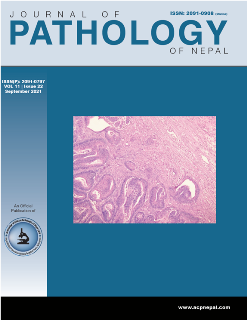Use of hematological parameters as an early screening tool for neonatal sepsis
DOI:
https://doi.org/10.3126/jpn.v11i2.33781Keywords:
Blood culture; Hematological scoring system; Neonates; SepsisAbstract
Background: Neonatal sepsis continues to be a major public health problem in developing countries. Due to the nonspecific clinical manifestations of neonatal sepsis, the longer turnaround time for culture reports, an early diagnostic tool is essential for the initiation of appropriate and timely treatment.
Materials and Methods: This is a cross-sectional study of 470 clinically suspected cases of neonatal sepsis admitted in the pediatrics department of B.P. Koirala Institute of Health Sciences, Dharan, Nepal. Following hematological parameters: abnormal total leucocyte count, abnormal total polymorphonuclear count, elevated immature Neutrophils count, elevated immature to total neutrophil ratio, immature to mature neutrophils ratio ≥ 0.3, platelet count ≤ 150,000/mm3, and pronounced degenerative changes in Neutrophils were assessed and a score of 1 was assigned to each as per the hematological scoring system of Rodwell. A score ≥ 3 was considered positive and a score < 3 was considered negative for the diagnosis of sepsis. Blood culture was taken as a gold standard for diagnosis of neonatal sepsis
Results: Hematological scoring system had fairly high sensitivity, specificity, NPV, and PPV; i.e. 85.96%, 84.26%, 84.52%, and 85.71% respectively. The diagnostic accuracy of HSS was high (85.1%) in comparison to the maximum diagnostic accuracy of individual hematological parameters, i.e. 74.46% for the total neutrophil count.
Conclusions: Hematological scoring system can be used as a convenient and early diagnostic tool against neonatal sepsis in developing countries with a high burden of neonatal sepsis because of its high sensitivity and easy availability.
Downloads
Downloads
Published
How to Cite
Issue
Section
License
Copyright (c) 2021 Bindu Adhikari, Punam Paudyal, Paricha Upadhyaya, Jyoti Agrawal, Basudha Khanal

This work is licensed under a Creative Commons Attribution 4.0 International License.
This license enables reusers to distribute, remix, adapt, and build upon the material in any medium or format, so long as attribution is given to the creator. The license allows for commercial use.




